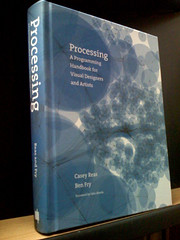
 It’s rare to read a book on computer programming, written by the guys who actually created the language. Processing: A Programming Handbook for Visual Designers and Artists (The MIT Press) is one.
It’s rare to read a book on computer programming, written by the guys who actually created the language. Processing: A Programming Handbook for Visual Designers and Artists (The MIT Press) is one.
But hold on, what is Processing? Put simply, a programming language for people who want to create images, animation and interactivity without having to master creativity-numbing “real” programming languages like C++. With a low threshold for entry, anyone — particularly non programming types like artists and architects — can jump in and start playing around. After downloading and installing Processing, within minutes I was tinkering with the code. There is one program that draws a tower made of bricks; it was a simple matter to change the color, dimensions and quantity of the bricks, and alter the direction and speed that the tower spun around. Granted, this is kid’s play, but it illustrates how accessible the code is. Without needing a cumbersome runtime environment or having to compile code prior to use, playing around with Processing is quick and easy.
As I mentioned, Casey Reas and Ben Fry not only authored the book but they also created the language. These days Reas is an Associate Professor at UCLA and Fry works as a designer in Cambridge, MA but they collaborated while graduate students at MIT’s legendary Aesthetics + Computation Group. “At the time, few software environments afforded both a sophisticated programming language and the ability to create refine graphics,” Reas said in the book’s introduction. So he and his colleagues created their own. Based off of Java, Processing was the culmination of years of software development and classroom work.
The book covers such typical programming topics as math, drawing shapes, and arrays, as well as more unusual subjects like typography, along with housekeeping sections on code structure and debugging. While tutorials make up the bulk of the book, the authors have interspersed numerous essays and interviews, illustrating the fact that Processing is much more than just two guys. As an open-source initiative, more people than the authors could mention contributed. Processing is densely packed with instruction and code samples, providing ample opportunity for newbies to get comfortable with the language.
While still in its infancy, Processing seemingly has unlimited potential. One of the goals of the project was to develop Processing as a free and open source language. As such it has found a following with geeky DIYers, Linux-heads and other fans of the open-source movement. Who knows where you’ll find Processing a few years from now? One of the most fascinating applications of Processing is the programming of microcontrollers. A variant called Wiring is used to control Arduinos and other microcontrollers, adding the ability to take Processing-based art out of the computer and into the gallery or anywhere else. Wearable light displays, interactive sculpture, stuff like that is going to get a lot more commonplace as the technology spreads.
Download Programming from processing.org and start tinkering today.
